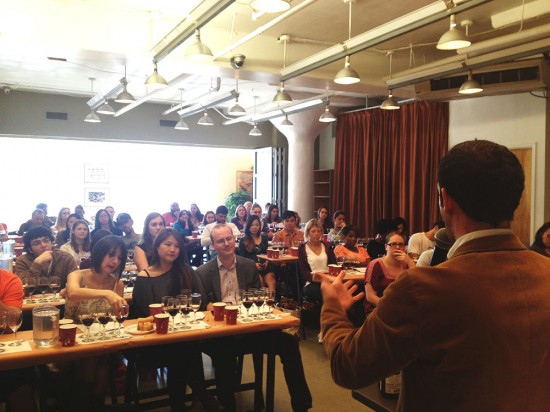Celebrated sommelier Michael Madrigale grew up in an Italian-American family in Pennsylvania. His first job was in a butcher shop, followed by a stint in marketing, which conclusively taught him that he wasn't one for a desk job. From there, he sought employment as a waiter, which enabled him to learn more about food. When he finally fell upon a position at a Burgundy-only wine shop in the West Village, he embarked on his lifelong love affair with wine.
![photo[5]](/sites/default/files/inline-images/migrated/2013/10/photo5-550x733.jpg)
Today, Madrigale is the Head Sommelier of Bar Boulud, Boulud Sud and Epicierie Boulud (some of the restaurants of Chef Daniel Boulud’s Dinex Group empire). In 2012, he won Wine Enthusiast’s Sommelier of the Year Award and one of Food & Wine’s Sommelier of the Year Awards.
This month, we were thrilled to have him share his insight about wine selection and pairing with our students and alumni.
![photo[4]](/sites/default/files/inline-images/migrated/2013/10/photo4-550x412.jpg)
Michael loves his job because he is able to taste all kinds of wines that he might not otherwise have the access or the means to enjoy on his own accord. Fortunately for us, he chose six wines that he personally buys to drink at home, all of which are relatively inexpensive. Each represented something very important to him that is not commonly found in wines at this price level--for example, the soil imprint from the region they are grown.
Indeed, one of Michael's six picks--NV Domanine Tissot, Cremant du Jura--while not a Champagne or pricey sparkling wine, contains the desired characteristic of that breed: a lot of minerality. It acquires this minerality from being grown in a limestone ridge from the Jurassic period (yes, think dinosaurs), which contains fossilized sea life. Plus, if a table is ordering a variety of vegetarian, fish or meat dishes, this type of sparkling wine can really show its pairing versatility.

We learned that the vines of the 2011 Weingut Salomon, Riesling “SteinTerrassen” have to work extra hard to dig through the granite hillside of the Danube River in order to reach a water source, resulting in fewer but higher quality grapes. You could really smell the rubbery “petrol” smell that Michael says is associated with Rieslings.
Further, those of us who shunned Chablis because of our early boxed-wine drinking days gained a new-found appreciation after tasting Michael's artisanal example. Michael explained that California "Chablis" was responsible for giving the wine a bad name, when in reality, the 2011 Domaine Bessin Chablis from Burgundy was stony, not oaky, and crisp, while still fleshy and rich. Its round weight on the palate lends itself to food, not youthful debauchery.
My favorite, the 2007 Domaine Bernard Faurie, Saint Joseph, hails from the Northern Rhone region of France. While this region is not commonly regaled, Michael feels it is the greatest wine region in the world. This funky red wine was redolent of black pepper, with a soulful quality that makes it a fine pairing for wild mushrooms, game or liver.
![photo[2]](/sites/default/files/inline-images/migrated/2013/10/photo2-550x412.jpg)
While Michael certainly taught us a lot, he also cautioned us that no matter how knowledgeable we become about wine, we should keep in mind that taste is subjective.
Consequently, Michael encouraged us to form our own opinions while allowing others to form theirs.
If you are eager to put Michael's advice into practice and taste for yourself, check out the next edition of The Main Course, ICE's course catalog, to see what other wine tastings we have planned for you!

